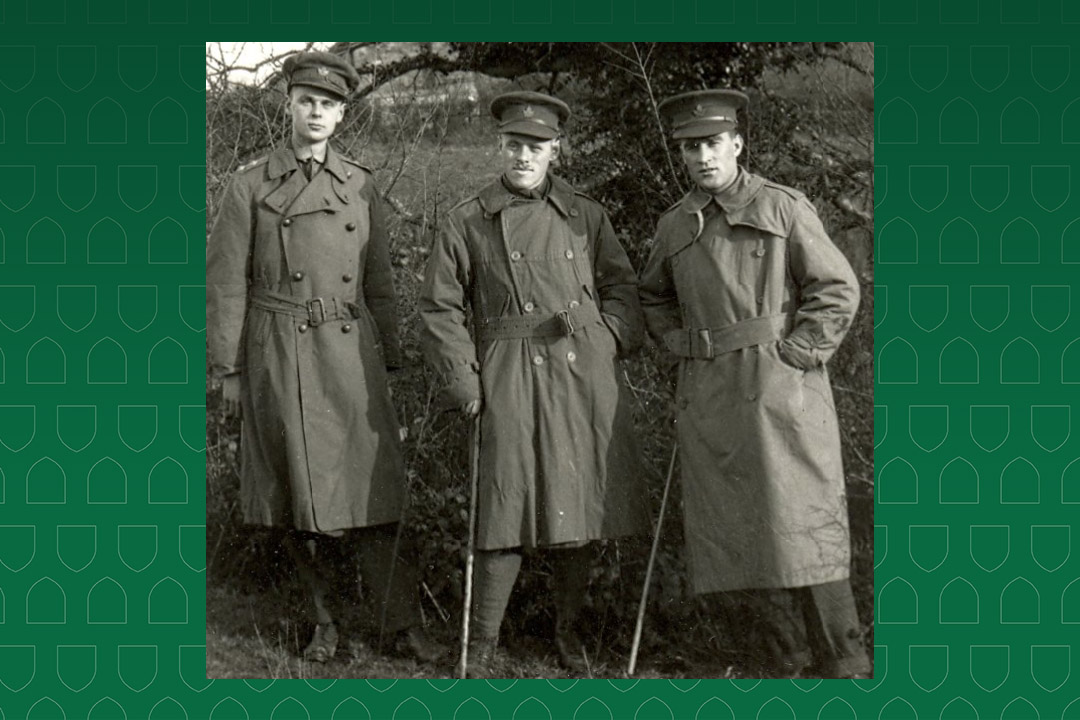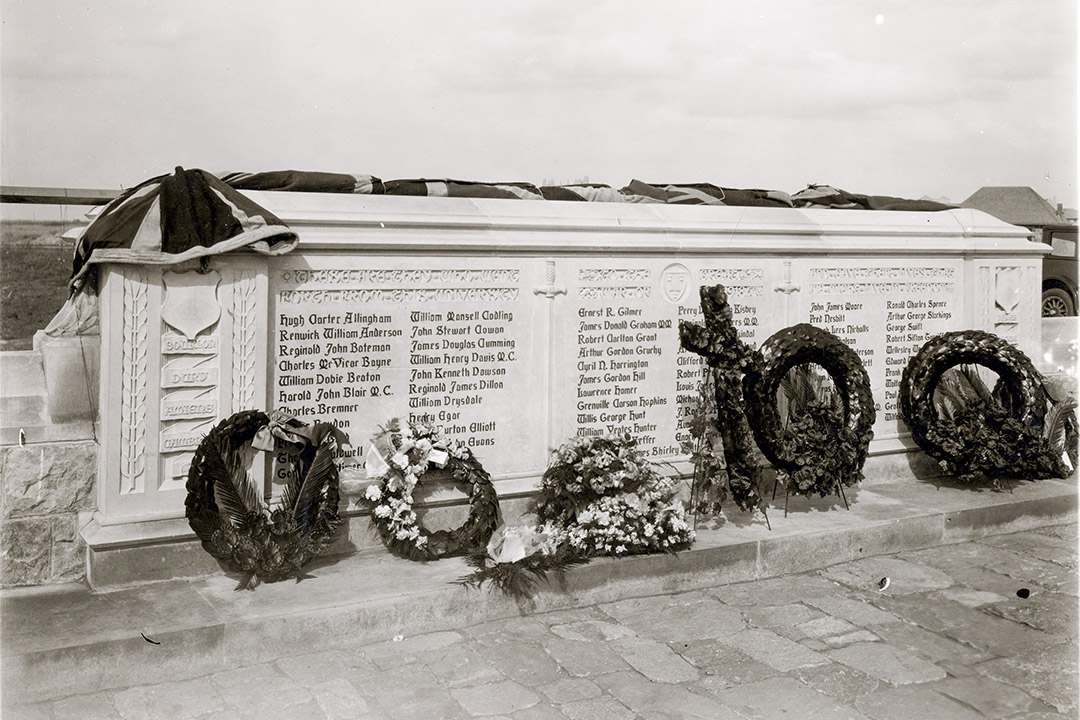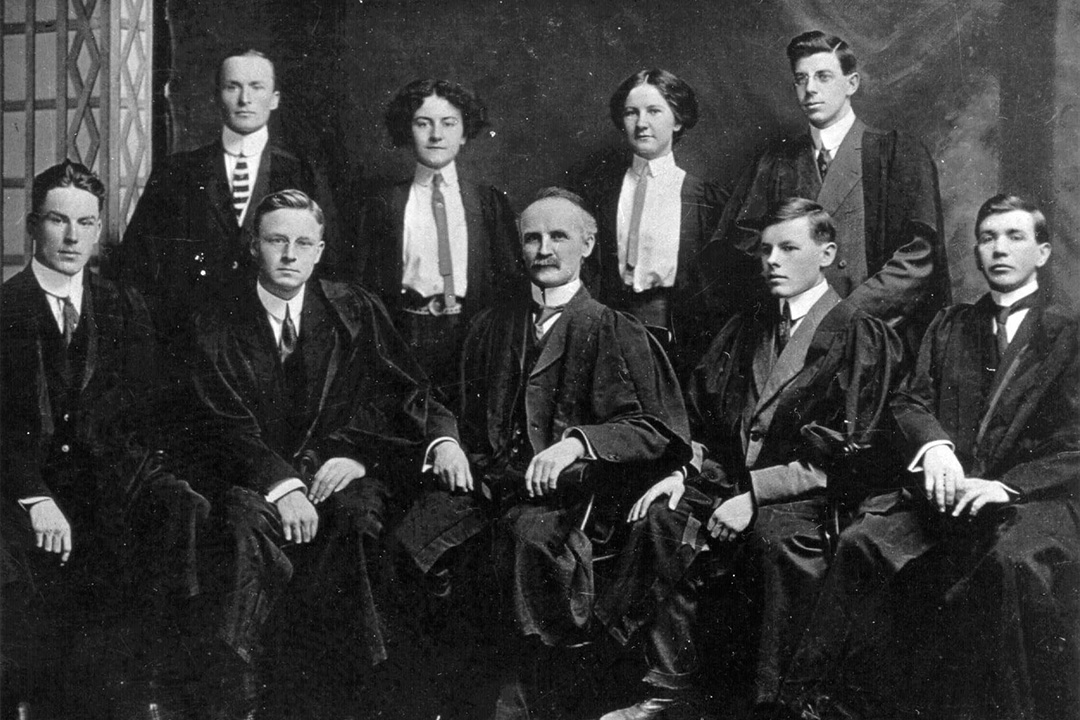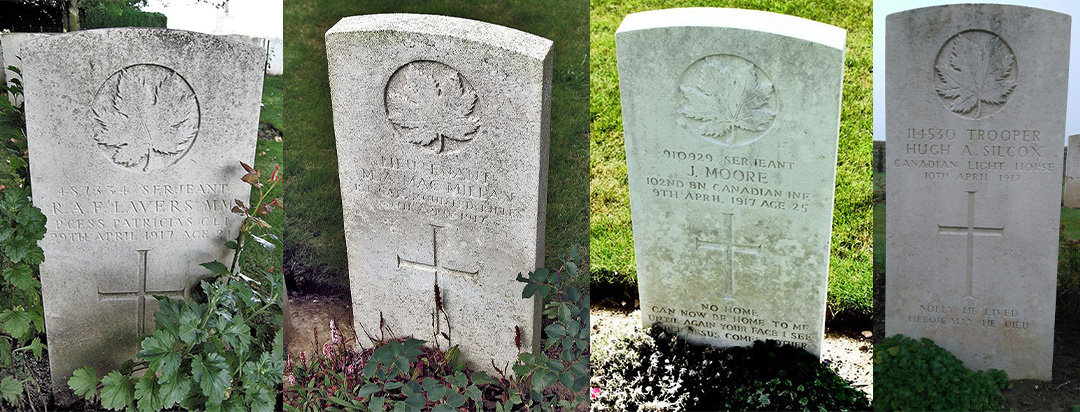
Vimy Ridge Day: Honouring the sacrifice of soldiers from USask
It was one of the defining moments in Canadian military history, with students and staff from the University of Saskatchewan (USask) among those who made the ultimate sacrifice during the Battle of Vimy Ridge.
By James ShewagaA German stronghold since 1914, Vimy Ridge in northern France was the site of tremendous losses by the French and British armies in 1915 and 1916, before the Canadian Corps finally captured the ridge a year later during a historic four-day battle from April 9-12, 1917. In all, 3,598 Canadians were killed and more than 7,000 wounded during the Battle of Vimy Ridge, including nine of the 69 soldiers from USask who were killed during the First World War out of the 345 students, staff, faculty and alumni who served.
Canadian Brigadier-General Alexander Ross, who was raised in Regina and commanded the 28th Canadian Battalion at Vimy Ridge, later wrote about the assault on the morning of April 9: “It was Canada from the Atlantic to the Pacific on parade,” said Ross, who was awarded an honorary degree at USask in 1955. “I thought then that in those few minutes, I witnessed the birth of a nation.”
“Because all four Canadian divisions attacked together and all regions of Canada were present in the battle, Vimy became a symbol of what Canadians could do together,” wrote historian Tim Cook in his book Shock Troops: Canadians Fighting The Great War 1917-1918.

As Canada prepares to commemorate Vimy Ridge Day on April 9 – the first day of the historic battle – On Campus News profiles the nine soldiers from the University of Saskatchewan who were killed during the assault, and in the days following to secure the ridge and surrounding area. Many of their stories are documented by University Archives and Special Collections in The Great War website.
Private James Brydon
Born Dec. 11, 1884. Died April 10, 1917.
Originally from Scotland, Brydon emigrated to Canada and was working as a herdsman at the university when he voluntarily enlisted in Saskatoon in early 1916, joining the Saskatchewan Regiment, 196th Battalion. He was killed on the second day of the battle on April 10, 1917, and is commemorated on the Vimy Memorial inscribed with the names of more than 11,000 Canadian soldiers who perished in France during the Great War with no known grave. He was 32.
A letter from the Canadian defence department in Ottawa to his brother Thomas B. Brydon at the University Farm, dated December 18, 1922, stated: “Referring further to the regretted death of the late Private Brydon, will you please note that this soldier, with others, was originally reported buried in a military cemetery in France, but when concentration of the bodies buried in this cemetery took place, in spite of extensive digging, only seven bodies were found and it was not possible to identify any of those. As a result of investigation, it was decided to erect a memorial in Canadian Cemetery No.2, Neuville, bearing the names of the soldiers who were originally recorded as buried in the burial ground referred to above, and that records in respect of the grave of the marginally named soldier had necessarily to be marked ‘No Trace on Research.’”
Corporal Thomas Caldwell
Born Dec. 1, 1891. Died April 9-10, 1917.
Caldwell grew up in Yorkton and came to the university in 1912, playing on the Agro hockey team as a defenceman and later became a member of the first graduating class in agriculture in the spring of 1915, before joining classmates in enlisting in the fall. A member of the Princess Patricia Canadian Light Infantry (PPCLI), Caldwell was part of the Saskatchewan-led 5th Battalion that was in the thick of the Battle of Vimy Ridge, with the two forward companies losing 200 of their 300 men in the first 40 minutes alone. Caldwell was later killed by a German sniper while serving outpost duty, with his comrades placing a small wooden cross where he fell on the slopes of Vimy Ridge. He was 25.
“Interestingly, his tombstone at Vimy Ridge says he died April 9-10, 1917, so nobody really knows precisely which day,” said Caldwell’s great-nephew David Henley, whose family attended the annual Remembrance Day service at the university’s Memorial Gates in 2018. “We were lucky enough to be there at Vimy Ridge in November of 2016 when they were commemorating 100 years since the First World War.”
Sergeant Reginald Adolphus Frederick Lavers
Born: Feb. 12, 1893. Died: April 29, 1917.
Lavers came from England to Canada in 1913 as an Anglican divinity student at Emmanuel College on campus, affiliated with the university. Renowned for his abilities as a soccer player and singer, he enlisted in the fall of 1915 and served with the PPCLI’s 5th Battalion, and was wounded in combat by shelling in 1916 and awarded the Military Medal for bravery in the field. Lavers later survived the initial four-day Battle of Vimy Ridge, before being killed by random shelling two weeks later while serving rations in the trenches during the stalemate that followed. He was 24.
His official military record reported: “During the operations of 9th April at Vimy Ridge, this non-commissioned officer (NCO) greatly distinguished himself during consolidation of our Final Objective. He took charge of a wiring party in advance of our Left Company and although all his party became casualties from snipers, he stuck to his work and himself completed the construction of the wire in front of the position. A short time later, he found himself the senior NCO in his company and carried on the duties of Company Sergeant Major in a most excellent manner.” A newspaper clipping at the time stated: “The gallant young sergeant’s officer, in writing, remarked on his straightforwardness of character and on his quietly-exercised and splendid influence. He had been recommended for a commission just before his death.”
Lavers is buried near Vimy Ridge at the La Chaudière military cemetery south of Lens, France.
Lieutenant Arthur Stephen Kenyon Lloyd
Born: Sept. 12, 1895. Died: May 7, 1917.
Another divinity student from Emmanuel College, Arthur Lloyd enlisted a few months after the start of the war on Oct. 26, 1914, along with his brother William Exton Lloyd – who studied law at the university and was a member of the university’s first hockey, and track and field teams, as well as the varsity soccer league champions in 1909. They were the sons of Reverend George Exton Lloyd, who was the head of Emmanual College and later became the Anglican bishop of Saskatchewan, and whom the city of Lloydminster is named after. Enlisting as a private and rising to the rank of lieutenant, Arthur Lloyd was a member of the Canadian Infantry Regiment (28th Battalion) and survived the main assault on Vimy Ridge, but died when hit three weeks later in the trench warfare following the battle. His name is inscribed on the Vimy Memorial, one of the 11,000 Canadian soldiers listed as “Missing, presumed dead” in France. He was only 21.
During the war, his brother William Lloyd wrote a letter from the front that was published in The Sheaf newspaper in 1915: From Corporal W.E. Lloyd, Bomb Throwers Section, 28th Battalion, Sept. 29, 1915. “On Monday about 4:30 pm, Stanley Killick, a Saskatoon boy, called me around to his fire to have some tea. We were both standing beside the fire when Fritz sends over a bomb from a trench mortar. It exploded as soon as it hit a ledge, about four feet high, and instantly killed poor old Killick, and shifted me about 20 feet, with no harm whatever except a bruised leg. So now I am in a field ambulance station recuperating from my little trip, and expect to join the battalion in a couple of days.”
William Lloyd rose to the rank of captain, was twice wounded and survived the war, later passing away at the age of 36.
A third brother, Captain Frank Percy Lloyd, who studied medicine at USask, also served in The Great War, was wounded a month after the Battle of Vimy Ridge, but also survived and went on to become a doctor in Ontario.
Lieutenant Michael Allan MacMillan
Born: Dec. 25, 1892. Died: April 9, 1917.
Born in Clermont, P.E.I., MacMillan came west to Saskatoon and enrolled in university in 1911, graduating with a bachelor’s degree in 1915 before beginning law studies. A popular student, MacMillan was president of the Student Representative Council, with his profile in The Sheaf reading, “All who know Mac expect great results in his chosen career, the Law, and wish him every success.” However, MacMillan was drawn by the call to serve and joined his close friends and fellow law students Hugh Aird and John Diefenbaker in enlisting together in Regina on Aug. 25, 1916, with the 1st Canadian Mounted Rifles (Saskatchewan Regiment). Diefenbaker was injured in a military training accident in England and later medically discharged and returned home, and would later serve as Canada’s 13th Prime Minister and as the chancellor of the University of Saskatchewan, and was buried on campus after his passing in 1979.
For their part, his law school classmates MacMillan and Aird both went on to take part in the assault on Vimy Ridge, with Aird wounded and MacMillan killed in action on the first day of the battle on April 9, 1917. He was 24 years old. MacMillan, whose brother William went on to serve as premier of P.E.I. from 1933-35, now lies forever at rest in Nine Elms Military Cemetery, five kilometres away from the Canadian Vimy Memorial. Meanwhile, Aird suffered what was recorded in his military records as a “severe” shrapnel wound to his back and spent weeks in hospital recovering, but survived the war. However, his younger brother, Lieutenant William Douglas Aird of Saskatoon, who also fought at Vimy Ridge, was later killed in another historic Canadian battle at Passchendaele on Oct. 26, 1917. He was only 20 years old.
Corporal Enoch Aldred Mitchell
Born: March 30, 1894. Died: April 10, 1917.
Born and raised in Grenfell, Mitchell studied agriculture at USask from 1912-1914 before enlisting Dec.14, 1914 at the age of 20 and serving in France with the Canadian Expeditionary Force’s 10th machine gun battalion. A decorated soldier, Mitchell was first wounded in 1916 and temporarily promoted to sergeant on the battlefield. He later rejoined his unit and took part in the Battle of Vimy Ridge where he was mortally wounded and died in a field hospital on April 10, 1917, on the second day of the assault at the age of 23. He is buried at Barlin Communal Cemetery near Vimy Ridge.
On Nov. 27, 1918, his father John Mitchell wrote a letter to the Dean of Agriculture, William Rutherford, informing him of his son Enoch’s death: “Dear Sir, My Son E. A. Mitchell enlisted in the 10th Battalion machine gun section, Nov. 1914. After the battle of Ypres, was sent to France where he has been in all engagements since. Was slightly wounded in 1916, was promoted to sergeant on the battlefield, was mortally wounded near Bethune in April. Died in No.6 Casualty Clearing Hospital, April 10, 1917. Buried in Barlin Cemetery.”
Tragically, Enoch’s older brother Private Frank Mitchell was also killed in action at the age of 27 near Vimy Ridge just 18 days later on April 28, 1917, while serving with the Canadian Infantry’s 8th Battalion. A third brother, Private Ernest Gordon Mitchell, had also registered for classes at the University of Saskatchewan in 1914 but joined the war effort instead, enlisting in the fall of 1914 with the Strathcona Horse regiment. He fought in France and survived the war, and was discharged with a severe case of influenza, returning home in the spring of 1919. He later worked for the federal government’s agriculture department until his passing in 1975 at the age of 78.

Sergeant John James Moore
Born: May 25, 1891. Died: April 9, 1917.
Moore was one of the seven members of the University of Saskatchewan’s historic first graduating Class of 1912, earning a bachelor’s degree with a focus on law. The son of Reverend W. S. Moore and Jeanie W. Moore of Prince Albert, Moore served as president of the university’s Literary Society in his final year of classes, and was a member of the YMCA executive. A superb athlete, Moore also excelled in boxing and soccer at USask, helping lead his soccer squad to a league championship. Four years after graduating, he returned to Saskatoon to enlist with the USask-based 196th Battalion in the spring of 1916 to join the war effort overseas, quickly earning promotion to sergeant.
After arriving in England and being transferred to the 102nd Canadian Infantry battalion, a unit that was at the forefront of the attack in the heart of the battle for Vimy Ridge, killed on April 9 on the first day of the attack that began at 5:30 am on Easter Monday. Today, Moore lies near where he fell more than a century ago in France, buried in Canadian Cemetery No.2, one kilometre away from the Canadian Memorial at Vimy. He was remembered in a touching tribute in The Sheaf in the fall of 1917: “To his relatives in their loss goes our sincerest sympathy. To lose a loved one in such a cause brings out feelings that words are inadequate to convey.” Moore was 25 years old.
Private Robert Rousay Jr.
Born: Nov. 30, 1896. Died: May 6, 1917.

Another one of the many Agros who volunteered for duty in the First World War, Rousay attended university from 1914-15, and was farming briefly before enlisting with the 188th Battalion on Nov. 16, 1915, in his hometown of Yorkton. After heading overseas to England, Rousay was transferred to the 47th Battalion to join the fight in France. He survived the main Battle for Vimy Ridge, but was killed in action four weeks later near the community of Lens, just a few kilometres north of the ridge. Rousay is one of the more than 11,000 names of Canadian servicemen inscribed on the ramparts of the Vimy Memorial for soldiers whose bodies were never identified or whose graves were never marked.
His father, Robert Rousay Sr., one of the original white settlers in the Yorkton area, wrote to Agriculture Dean William Rutherford about his son’s death: “Dear Sir, Re your letter of inquiry regarding my son Robert, who attended your college in the winter of 1914-15. I am sorry to inform you that he was killed in action on the 6th of May 1917 near Lens in France. He enlisted in the fall of 1915 with the 188th Battalion. Trained in Yorkton that winter at Sewall, next summer went overseas with the 96th Highlanders from Winnipeg in the fall of 1916. Transferred to D Company, 47th Battalion in England with which he was with at the time he was killed. Yours truly, Robert Rousay, Yorkton, Sask.”
Robert Rousay Jr. was only 20 years old when he died.
Private Hugh Alfred Silcox
Born: June 27, 1891. Died: April 10, 1917.
Born and raised in Ontario, Silcox came west to study engineering at USask from 1913-14 and had just started teaching when he voluntarily enlisted in Saskatoon on Dec. 19, 1914, joining the 1st Canadian Light Horse regiment. Silcox fell on the first day of the Battle of Vimy Ridge, hit by shelling and suffering a fractured arm and leg, succumbing to his wounds the next day in a field hospital at the front on April 10. He is buried in France’s Quatre-Vents Military Cemetery, a few kilometres east of Vimy Ridge. The inscription on his headstone reads: “Nobly he lived, heroically he died.” He was 25.
Silcox’s first cousin Corporal Sidney Cliford Silcox was also wounded in the Battle of Vimy Ridge but survived, and was later killed instantly by machine gun first in an attack near Sancourt, France, only 41 days before the end of the war.
Trooper Hugh Silcox is one of the 69 names inscribed on the Memorial Gates monument in memory of the University of Saskatchewan students, staff, faculty and alumni who were killed in the First World War.

Photo above: From left: The grave marker of Sergeant Reginald Lavers at La Chaudière Military Cemetery near Vimy Ridge. (Photo: John & Anne Stephens, courtesy of The Canadian Virtual War Memorial). The final resting place of Private Hugh Silcox in France’s Quatre-Vents Military Cemetery, a few kilometres east of Vimy Ridge. (Photo: Courtesy of Imperial War Museums). The headstone and gravesite of former University of Saskatchewan student John James Moore in the Canadian cemetery in Pas de Calais, France, one kilometre south of the Canadian Memorial at Vimy Ridge. (Photo: Courtesy of The Canadian Virtual War Memorial). Lieutenant Michael Allan MacMillan lies forever at rest in Nine Elms Military Cemetery, five kilometres away from the Canadian Vimy Memorial. (Photo: Courtesy of John and Anne Stephens, Canadian Virtual War Memorial).
Article re-posted on .
View original article.
Together we will support and inspire students to succeed. We invite you to join by supporting current and future students' needs at USask.

